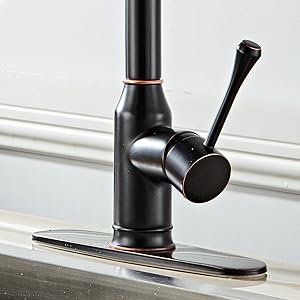Understanding the various parts of a single-handle kitchen faucet is essential for homeowners who want to maintain or repair their fixtures. While the design and components may vary slightly depending on the brand and model, most single-handle kitchen faucets share common parts. These include the faucet body, handle, spout, cartridge, aerator, O-rings, and mounting hardware. Each part plays a specific role in the function and operation of the faucet, and knowing how they work together can help troubleshoot issues and perform maintenance tasks.
The faucet body is the main housing that contains the internal components of the faucet, including the cartridge and other moving parts. It typically connects to the countertop or sink through mounting hardware, such as nuts and washers, which secure it in place. The handle is attached to the faucet body and is used to control the flow and temperature of the water. It may feature a lever or knob design, depending on the style of the faucet.
The spout is the protruding nozzle that delivers water from the faucet to the sink. It may be fixed or swivel for added flexibility and convenience. Inside the faucet body, the cartridge is the component responsible for controlling the flow and temperature of the water. It contains rubber seals and ceramic discs that open and close to regulate the water flow and mix hot and cold water. Over time, the cartridge may wear out or become damaged, leading to leaks or difficulty in operating the faucet.

The aerator is a small component located at the tip of the spout that helps regulate the flow of water and reduce splashing. It features a fine mesh screen that filters out debris and sediment from the water, improving water quality and preventing clogs. O-rings are rubber seals located around the base of the faucet body and other connections to prevent leaks. These seals may degrade over time due to exposure to water and minerals, leading to leaks around the base of the faucet.
Other parts of a single-handle kitchen faucet include the supply lines, which connect the faucet to the hot and cold water supply lines under the sink. These lines are typically made of flexible braided stainless steel for durability and ease of installation. Additionally, some faucets may feature a side sprayer or soap dispenser as optional accessories, which require additional parts and connections.
When it comes to troubleshooting issues with a single-handle kitchen faucet, identifying the faulty part is the first step in the repair process. Common problems include leaks, drips, low water pressure, and difficulty in adjusting the temperature. In many cases, the issue can be traced back to a specific part, such as a worn-out cartridge, damaged O-ring, or clogged aerator.

To repair a single-handle kitchen faucet, homeowners will need basic tools such as an adjustable wrench, screwdriver, and pliers, as well as replacement parts specific to their faucet model. Before starting any repairs, it’s important to shut off the water supply to the faucet and drain any remaining water from the lines to prevent leaks and spills. Once the faulty part has been identified, it can be removed and replaced with a new one following the manufacturer’s instructions.
Regular maintenance is key to ensuring the long-term performance and durability of a single-handle kitchen faucet. This includes cleaning the aerator and removing any buildup of sediment or debris, inspecting and replacing worn-out O-rings and seals, and lubricating moving parts to prevent friction and wear. By taking care of these tasks regularly, homeowners can prolong the life of their faucets and prevent costly repairs in the future.
Single-handle kitchen faucets are comprised of various parts that work together to control the flow and temperature of water. Understanding the function and operation of these parts is essential for homeowners who want to maintain or repair their fixtures. By identifying and addressing issues with specific components, such as the cartridge, aerator, or O-rings, homeowners can keep their faucets in optimal condition and prevent leaks and other common problems. Regular maintenance and occasional repairs are key to ensuring the long-term performance and durability of single-handle kitchen faucets.

Kohler Single Handle Shower Faucet Cartridge

Single handle kitchen faucets from the traditional to the modern

Commercial Kitchen Faucet/Single Handle High Arc/Pull Down Sprayer Spring/Kitchen Sink Faucet

How to Install a Single-Handle Kitchen Faucet how-tos DIY

Single Lever Kitchen Faucet Second Use

Delta Kitchen Faucet Leak Repair (Single Handle) Sparky Channel Videos

Kingston Brass Restoration Single Handle Kitchen Faucet & Reviews Wayfair

Related Posts:
- Project Source Pull Down Kitchen Faucet
- Delta Dryden Kitchen Faucet
- Delta Single Handle Kitchen Faucet With Spray Repair
- Moen Copper Finish Kitchen Faucet
- Best Single Handle Pulldown Kitchen Faucet
- How To Take Apart A Delta Kitchen Faucet Sprayer
- Glacier Bay Touchless Kitchen Faucet W Led
- Three Hole Kitchen Sink Faucet
- Premier Charlestown Kitchen Faucet
- Water Filter System For Kitchen Faucet